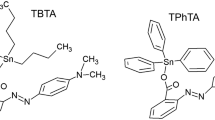Organotin compounds examined in this study exhibited a relative order of potency for induction of in vitro hemolysis in human erythrocytes as follows: tri-n-butyltin > tri-n propyltin > tetra-n-butyltin > triphenyltin chloride > tri-n-ethyltin bromide > dibutyltin dichloride > stannous chloride > tri-n-methyltin chloride = butyltin chloride dihydroxide. All of the organotin compounds induced erythrocyte shape transformation from the normal discocyte to an echinocyte and, in addition, triphenyltin chloride, tetra-n-butyltin and tri-n-ethyltin bromide also elicited stomatocyte formation at higher concentrations. Select organotin compounds also formed tin-containing aggregates within the plasma membrane. The relative order of effectiveness for organotin induction of intramembranous aggregates was tri-n-butyltin > tri-npropyltin > tetra-n-butyltin > tri-n-ethyltin bromide, which was based upon the lowest concentration at which they were observed. These results support the previously suggested theory that organotins are membrane effectors because of their comparatively high hydrophobic, lipid partitioning properties. The relatively lipophilic compound, triphenyltin chloride, appeared to be anomalous because it did not readily promote hemolysis or induce the formation of intramembranous aggregates in human erythrocytes. A log-linear statistical model demonstrated an association of hemolysis with both tri-n-butyltin aggregate formation and shape transformation. Select organotin compounds should be useful probes in membrane studies because of their numerous effects.
Similar content being viewed by others
Abbreviations
- DBT:
-
dibutylin dichloride
- MBT:
-
butyltinchloride dihydroxide
- SnCl2 :
-
stannous chloride
- TBT:
-
tri-n-butyltin
- TET:
-
tri-n-ethyltin bromide
- TMT:
-
tri-n-methyltin chloride
- TPhT:
-
triphenyltin chloride
- TPT:
-
tri-n-propyltin
- TTBT:
-
tetra-n-butyltin
References
ALDRIDGE, W.N. and CREMER, J.E. (1955). The biochemistry of organo-tin compounds: Diethyltin dichloride and triethytin sulfate. Biochem. J. 61:406–418.
ANDERSON, R.A. and MARCHESI, V.T. (1985). Regulation of the association of membrane skeletal protein 4.1 with glycophorin by a polyphosphoinositide. Nature 318:295–298.
ARAKAWA, Y. and WADA, O. (1984). Inhibition of neutrophil chemotaxis by organotin compounds. Biochem. Biophys. Res. Commun. 123:543–548.
BARCIKOWSKI, R.S. (1983). Computer Packages and Research Design, Vol. 1. University Press of America, Lanham, Maryland.
BISHOP, Y., FIENBERG, S. and MOLLAND, P. (1975). Discrete Multivariate Analysis: Theory and Practice. MIT Press, Cambridge, Massachusetts.
BYINGTON, K.H., YEH, R.Y. and FORTE, L.R. (1974). The hemolytic activity of some trialkyltin and triphenyltin compounds. Toxicol. Appl. Pharmacol. 27:230–240.
DAVIS, A.G. and SMITH, P.J. (1982). Tin. In: Comprehensive Organometallic Chemistry (Sir G. Wilkinson, F.G.A. Stone, and E.W. Abel, eds.), pp. 519–627. Pergamon Press, Oxford.
DEUTICKE, B. (1968). Transformation and restoration of biconcave shape of human erythrocytes induced by amphiphilic agents and changes of ionic environment. Biochim. Biophys. Acta 163:494–500.
DIXON, W.J. (1983). BMDP Statistical Software Manual. University of California Press, Berkeley, California.
FENDLER, J. (1983). Vesicles. In: Membrane Mimetic Chemistry. (J.H. Fendler, ed.), pp. 113–183. John Wiley and Sons, New York.
GRAY, B.H., PORVAZNIK, M., FLEMMING, C. and LEE, L.H. (1986). Inhibition of tributyltin mediated hemolysis by mercapto compounds. J. Appl. Toxicol. 6:363–370.
GRAY, B.H., PORVAZNIK, M. and LEE, L.H. (1986). Cyanide stimulation of tri-n-butyltin mediated hemolysis. J. Appl. Toxicol. 6:263–269.
KUYPERS, F.A., ROELOFSON, B., BERENDSEN, W., OP DEN KAMP, J.A.F. and VAN DEENEN, L.L.M. (1984). Shape changes in human erythrocytes induced by replacement of the native phosphatidylcholine with species containing various fatty acids. J. Cell Biol. 99:2260–2267.
LAUGHLIN, Jr., R.B., JOHANNESEN, R.B., FRENCH, W., GUARD, H. and BRINCKMAN, F.E. (1985). Structure-activity relationships for organotin compounds. Environ. Toxicol. Chem. 4:343–351.
MORROW, J.S. and ANDERSON, R.A. (1986). Shaping the too fluid bilayer. Lab. Invest. 54:237–240.
NAKAO, M., NAKAO, T. and YAMAZOE, S. (1960). Adenosine triphosphate and maintenance of shape of the human red cells. Nature 187:945–946.
PALEK, J., STEWART, G. and LIONETTI, F.J. (1974). The dependence of shape of human erythrocyte ghosts on calcium, magnesium and adenosine triphosphate. Blood 44:583–597.
PASHLEY, R.M., McGUIGGAN, P.M., NINHAM, B.W. and EVANS, D.F. (1985). Attractive forces between uncharged hydrophobic surfaces: Direct measurements in aqueous solution. Science 229:1088–1089.
PORVAZNIK, M., GRAY, B.H., MATTIE, D., JACKSON, A.G. and OMLOR, R.E. (1986). The ultrastructural localization of tri-n-butyltin in human erythrocyte membranes during shape transformation leading to hemolysis. Lab Invest. 54:254–267.
SELWYN, M.J. (1976). Triorganotin compounds as ionophores and inhibitors of ion translocating ATPases. In: Organotin Compounds: New Chemistry and Applications (J.J. Zuckerman, ed.), pp. 204–226. American Chemical Society, Washington.
SHEETZ, M.P. and SINGER, S.J. (1974). Biological membranes as bilayer couples. A molecular mechanism of drug-erythrocyte interactions. Proc. Natl. Acad. Sci. USA 71:4457–4461.
SHEETZ, M.P. and SINGER, S.J. (1976). Equilibrium and kinetic effects of drugs on the shape of human erythrocytes. J. Cell Biol. 70:247–251.
TALMON, Y., EVANS, D.F. and NINHAM, B.W. (1983). Spontaneous vesicles formed from hydroxide sufactants: Evidence from electron microscopy. Science 221:1047–1048.
WIETH, J.O. and TOSTESON, M.T. (1979). Organotin-mediated exchange diffusion of anions in human red cells. J. Gen. Physiol. 73:765–788.
WONG, P.T.S., CHAD, Y.K., KRAMER, O. and BENGERT, G.A. (1982). Structuretoxicity relationship of tin compounds on algae. Can. J. Fish. Aquat. Sci. 39:483–488.
WULF, R.G. and BYINGTON, K.H. (1975). On the structure-activity relationships and mechanism of organotin induced, nonenergy dependent swelling of liver mitochondria. Arch. Biochem. Biophys. 167:176–185.
YOSHIKAWA, H. and ISHII, M. (1962). Experimental studies on the toxicity of alkyltin compounds. II. The effects of butyltin salts on haemolysis in vitro. Bull. Nat. Inst. Ind. Health, Kawasaki 7:7–13.
Author information
Authors and Affiliations
Rights and permissions
About this article
Cite this article
Gray, B.H., Porvaznik, M., Flemming, C. et al. Organotin-induced hemolysis, shape transformation and intramembranous aggregates in human erythrocytes. Cell Biol Toxicol 3, 23–38 (1987). https://doi.org/10.1007/BF00117823
Received:
Accepted:
Issue Date:
DOI: https://doi.org/10.1007/BF00117823




